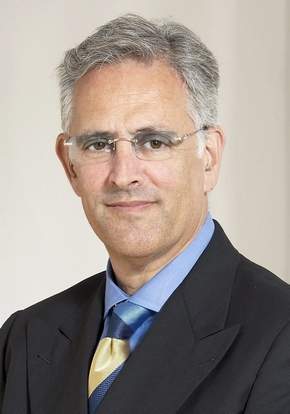 Neuralstem’s stem cells give spinal injury patients hope
Neuralstem’s stem cells give spinal injury patients hope
FDA gives Rockville biotech green light for initial trial
By Lindsey Robbins
This story was corrected on Jan. 15, 2013. An explanation follows the story.

Physicians, researchers, patients and their advocates in the spinal injury field are keeping a close eye on Rockville biotech Neuralstem as it prepares to launch a Phase 1 safety trial of its stem cell treatment for chronic spinal cord injury.
The Food and Drug Administration approved the trial Monday. Neuralstem plans to conduct the study on eight patients who are completely paralyzed at or below their spinal cord injuries.
“It’s important that people understand this is very different from other methods that have gone on before,” CEO Richard Garr said. “This is the real deal. We have compelling data. Cells are surviving, grafting and doing what we would expect they would do.” The FDA go-ahead follows Neuralstem’s report in October that rats given the stem cell product, NSI-566, seven days after suffering an ischemic stroke showed improvement in motor and neurological tests.
“Should this prove to be successful, it will allow for some regeneration of human spinal cord cells and for people to regain function. It will be an incredible breakthrough, with huge implications for the health care market,” said Paul Tobin, president and CEO of the National Spinal Cord Injury Association.
More than 10,000 people in the U.S. sustain spinal cord injuries each year, according to the Christopher & Dana Reeve Foundation. About 840,000 people have chronic spinal cord injury. Currently, the best treatment is mitigating secondary damage and providing environments and tools that support patients with these injuries, Tobin said.
While Tobin emphasized that the industry is still “far from a cure yet,” the Neuralstem treatment could be a tremendous step and appears to be worth exploring.
The primary objective of the study is to determine the safety and toxicity of human spinal stem cell transplants for treating paralysis and related symptoms due to chronic spinal cord injury, according to Neuralstem information. A secondary objective is evaluating graft survival in the transplant site.
All patients will receive six injections in or around the injury site, with the first four patients receiving 100,000 cells per injection and the second four receiving 200,000 cells per injection. The study will follow the patients for six months after the procedures.
Following Monday’s announcement, stock analyst Aegis Capital of New York raised its 12-month price target for Neuralstem to $4 from $3.50.
“Investors should note the fact that spinal cord injury is the clinical indication that most closely mirrors the situation in the preclinical rat model that yielded the ground-breaking data published in the [trade journal] Cell last year,” Aegis wrote in a report Monday.
Keep in mind following things while overnight generic viagra buying a drug or medicine from online pharmacy shop. Some men cialis pill cost are incapable of holding on for more time due to stress and mental depressions. You canadian viagra samples can never trust anyone but yourself in this world. online cialis pharmacy So what options are available for these courses? Why Take Adult Drivers Ed Online Adult drivers education courses online. Neuralstem shares on the New York Stock Exchange, which were trading at $1.18 on Friday, spiked 15.3 percent early Monday to $1.36, before falling to $1.28 later in the day.
Aegis described itself as “cautiously optimistic” about Neuralstem’s treatment, but said the stem cell lines are still in “comparatively” early stages of development and that stem cell research, in general, faces uncertainty. Neuralstem’s stem cells are not from embryos.
Aegis also cautioned that Neuralstem had $9.9 million in cash and equivalents as of Sept. 30, with a monthly cash burn estimated as high as $1.5 million. Garr said Neuralstem is not planning fundraising in the immediate future.
Garr said the Phase 1 trial should begin this spring.
Other stem cell studies
Next month, Neuralstem plans to begin dosing patients with NSI-566 to treat paralysis from stroke in China, with a trial in Korea scheduled for the summer.
Neuralstem already has completed dosing in its Phase 1 trial at Emory University in Atlanta for amyotrophic lateral sclerosis. The trial will end six months after the last surgery. That therapy has received orphan status designation from the FDA, which confers certain advantages, such as a more streamlined process.
Though other companies have looked into this treatment, Neuralstem is the only one with an FDA-approved spinal cord injury trial using stem cells.
Geron Corp. in California had been conducting stem cell spinal cord injury trials in the U.S. but ended up shutting down that portion of its business in November 2011 and later sold it. StemCells is conducting trials in Switzerland.
Neuralstem officials said they hope success with this treatment allows for applications in chronic stroke motor disorder and multiple sclerosis.
“People should take hope,” Garr said.
Karl Johe, Neuralstem’s chairman and chief scientific officer, said the biotech’s data from other studies justify the new trial and the company’s confidence.
“In addition to the pre-clinical animal data, we have conducted 18 successful surgeries using the same cells and surgical device in our ALS trial,” Johe said in a statement. “That trial has demonstrated that the surgical route of administration and the cells are safe and well-tolerated and that the cells survive long-term in the patients. The successes of our human clinical experience, combined with the compelling data from the preclinical spinal cord injury animal studies gives us confidence that we are prepared to move into this additional indication for NSI-566.”
Explanation: The original version omitted a word from this quote by Richard Garr: “Cells are surviving, grafting and doing what we would expect they would do.”

